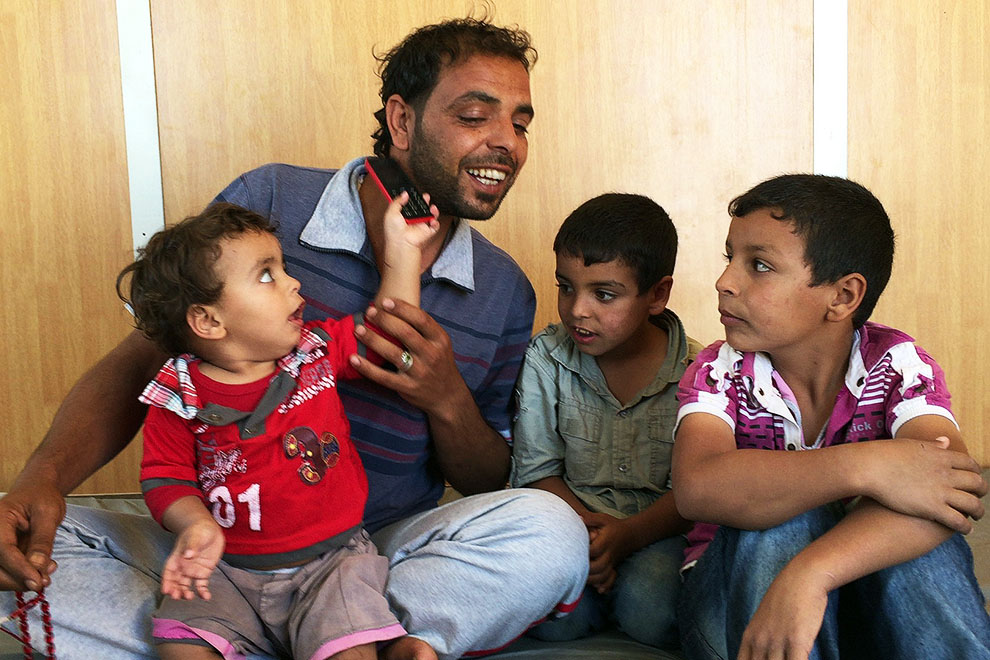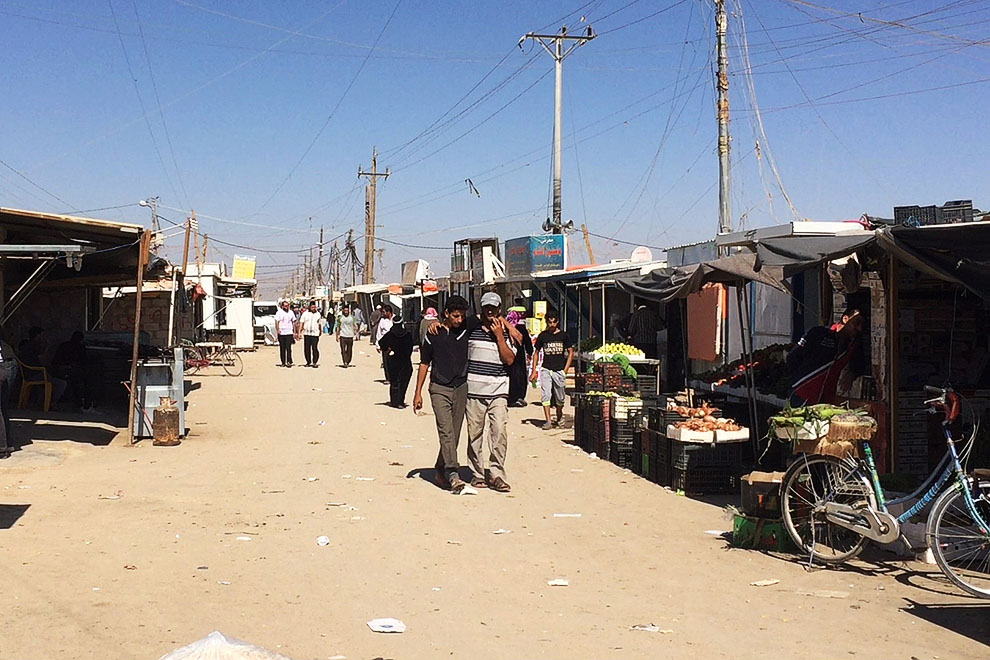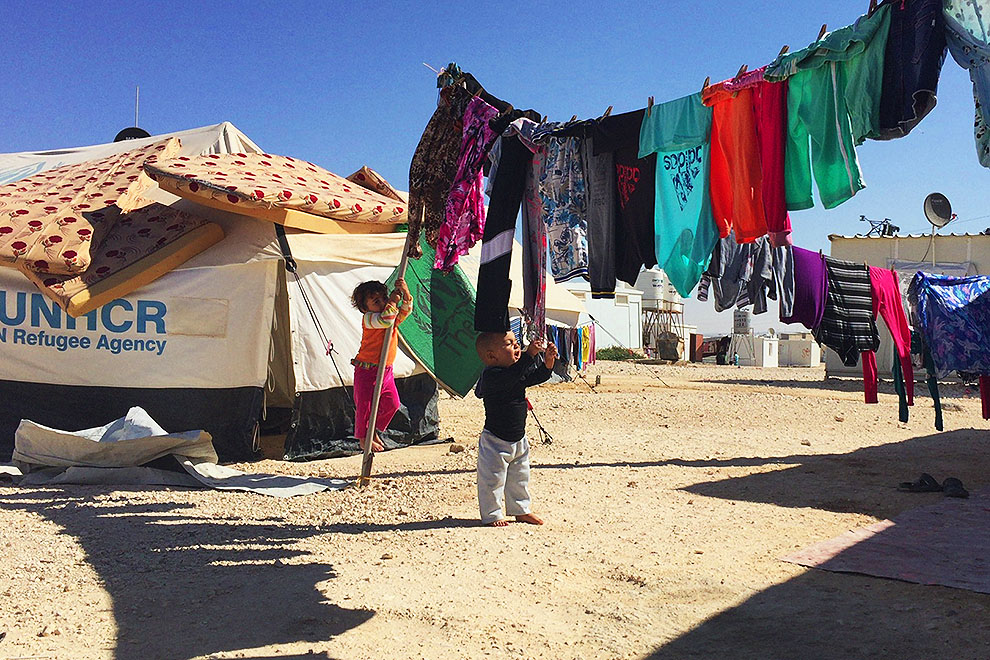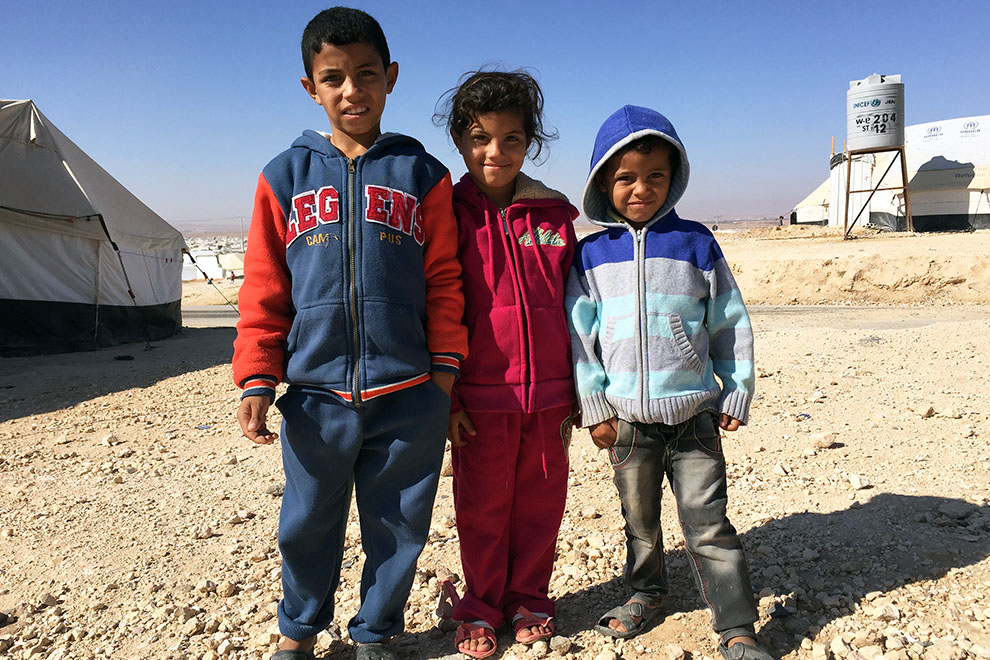I am sitting on a mattress on the floor of a demountable building in the Al Zaatari refugee camp in Jordan. After meeting me at a neighbour’s, Fatema brought me here to drink tea, meet some of her family, and tell me about her circumstances. She and her family have been living here since they fled the fighting in Syria.
Fatema is the lively matriarch of a family of twenty. Quick to laugh and brimming with stories from five decades of life in Syria, she explains how she ended up in the camp. “I saw myself dying,” she tells me. “We were all threatened. It was really hard for us. It was war. Would you stay in a place that had war? I had to take all my kids and flee. There was no food, there was nothing. Airstrikes every day.” She laments the loss: “Oh my village, oh my village. It is all demolished now. It is empty now.”
Jamal Ahmed is another of the millions of victims of the war in Syria. Although he isn’t part of Fatema’s family, he has joined us while we have been talking. With his greying stubble and moustache, he sits opposite me, smoking, next to Fatema’s son, Ibraheem. He has something to tell me, but I am preoccupied for a while with what others are saying. Eventually, though, our attention moves to Jamal, who tells me he was tortured by the Syrian regime and wants to show me the evidence. I am reluctant: I have seen enough of the remnants of torture, and it seems voyeuristic to comply. He also wants to show me YouTube videos of Syrians being tortured. I refuse the latter, but finally agree to look at his injuries.
He turns and lifts his shirt to reveal a scar the shape of a hawk stretching from one shoulder to the other. The skin, he says, was melted with a cigarette lighter by Syrian government torturers in the shape of the regime’s coat of arms. Now it sags unevenly.

“You have all that you want, but you can’t go out of here”: Jordan’s Zaartari refugee camp. Photos: David Corlett
Jamal was arrested after a neighbour reported him to Syrian intelligence, falsely and for profit, he says. What followed was a nightmare. For a year, he was incarcerated only a kilometre from his home in Sayeda Zainab. But it could have been a whole world away, and his family believed he was dead. As well as having his back mutilated, Jamal says that he was beaten with a hose and given electric shocks. His fellow prisoners thought he was doomed. “No one thought I would go out,” he says. “They slaughtered other people.” He saw these executions, he tells me, with his own eyes.
After his escape, he fled to Jordan with his wife and four children. Now he lives in the Al Zaatari camp.
From its highest point, barely a rise in the flat, barren landscape, the extent of the Al Zaatari camp becomes clear. Two and a half years after it was established here in northern Jordan, its seven square kilometres are home to more than 80,000 Syrian refugees, living just ten or so kilometres from the Syrian border as the crow flies.
This is an orderly camp, organised into districts and numbered streets. A remarkable variety of international agencies provide assistance with a wide range of services including housing, education, food and healthcare. The refugees are given vouchers to exchange for food; some sell them, losing value in the exchange, in order to have the greater flexibility that cash offers. Goods and services are bought and sold in the camp’s commercial district.
Although conditions are good compared with many other refugee camps around the world, and certainly preferable to the horrors that Syrians continue to flee, refugees in Al Zaatari are frustrated. Jamal Ahmed, for instance, complains that the medical care in the camp is inadequate. When he sought assistance, he tells me, his injuries, dramatic and unforgettable as they are, were documented as problems with his leg. He has trouble sleeping because of the pain, but says that he has not been given medicine to ease it. He believes that “no one cares.”
If you consider the international community’s commitment to Syrian refugees, he has a point. The UNHCR suggests it needs just over US$1 billion to respond adequately to Syrians who have fled to Jordan. It has received just over half that amount. This is consistent with the international response to the broader Syrian crisis, more than three million refugees and about six and a half million internally displaced persons, half of whom are children.
Fatema’s son, Ibraheem, is also dissatisfied with life in Al Zaatari. As we talk, he rolls cigarettes that are so strong that Fatema says they have branded them “Diesel.” His young sons come and go, variously sitting on or beside him; his niece asks him to repair a colourful and ornate hair clip. Someone brings him the newest addition to the family – the baby of one of his brothers. He delights in the children and they in him.

”I want to find a place where I can work,” says Ibraheem.
But, having escaped his hometown, Ghabegheb, in southern Syria about a year and a half ago, after a Syrian army attack, Ibraheem says he is now “like a bird living in a cage.” It’s not that he doesn’t have his basic material needs met: “You have food, you have water, you have all that you want, but you can’t go out of here. It’s really hard. It’s really difficult for me to be in a place where I can’t leave and I can’t see anything around me. Our kids, they can’t see anything outside.” If the Jordanian government let refugees leave the camp, he says, “we would be able to enlighten [the children] and show them other stuff.”
Conditions, although safe, are austere. Housed in configurations of tents and demountable buildings, these refugees feel that their lives are on hold and unfulfilled. “Our daily life is that we go for water, go back to our tents,” Ibraheem says. “Then we bring the bread.” For him, and many others, employment is key. “I want to work. I want to find a place where I can work,” he says. He wants to be able to provide for his family.
Complaints about conditions at Al Zaatari are at once understandable and unfair. It’s hardly surprising that refugees who face an uncertain and extended period in limbo are enormously frustrated. Their lives are in turmoil, and now, years after Syria began to implode, a resolution seems an ever more distant hope.
But Jordan – like other countries in the region – shoulders a considerable burden. Officially, it is home to 618,000 Syrian refugees, but some estimates put the figure as high as 1.3 million. Most of the refugees don’t live in camps like Al Zaatari but in increasingly perilous circumstances in cities and towns, despite the relative generosity of a host government that allows them access to state education and healthcare.
With Jordan’s population standing at around seven million people, the ratio of Syrian refugees to long-term Jordanian residents is one-to-eleven, on the official numbers, or around one-to-five using the unofficial estimates. By comparison, even at the peak of overall refugee arrivals in 2013, when 20,500 people reached Australia by boat, there was just one asylum seeker for every 1150 Australians. In the financial year 2013–14, following the success of the government’s efforts to stop asylum seeker boats, Australia’s humanitarian program included 13,768 places, 11,016 of which were granted to offshore applicants; in other words, Australia accepted refugees and others in need of protection at a rate of one to every 1700 Australians in that year.
If the numbers of refugees in Jordan and Australia are of different orders of magnitude, so are the capacities of the two countries. Jordan has a per capita GDP (standardised to international dollars) of $11,782, less than a third of Australia’s per capita GDP. (Cambodia’s is less than one-fourteenth of Australia’s.)
Australia hasn’t entirely ignored the situation in Syria and its neighbouring countries. In August, the Abbott government announced that it would take 2200 refugees from Syria and a further 2200 from Iraq. It could do this, the government said, because “stopping the boats” had freed up places in the humanitarian program. This is disingenuous: the Coalition had already walked away from its bipartisan acceptance of the recommendation by the Gillard government’s Expert Panel on Asylum Seekers that the humanitarian program should be increased to 20,000; had it kept to that commitment, Australia could have resettled a further 6000 refugees this year. (Earlier this month, as part of the deal to get the Senate to pass radical new legislation granting the immigration minister almost Caesar-like powers over the lives of asylum seekers, the government announced that it would increase Australia’s offshore refugee intake to 18,750 over the next four years.)
But more significant than the government’s obfuscation is the broader discourse into which it fits. Asserting a link between boat arrivals and offshore refugee resettlement feeds into the longstanding claim that refugees who arrive in Australia by boat are not only “jumping the queue” but also taking the places of other, more vulnerable refugees stuck in camps and slums around the world.
Stripped of its specificity, this is a claim to fairness, a notion that seems to be central in the Australian national psyche. As David Marr argued recently, Australians “hanker as much for fairness as we do liberty.” This emphasis on fairness is linked to notions of egalitarianism, tolerance and decency and is encapsulated in the notion of a fair go. It was the offence to fairness that landed the Abbott government’s first budget in trouble. And it is the perceived lack of fairness that leads many to disapprove of asylum seekers who can afford to board boats for Australia.
Many people on the political left have failed to grasp the significance of fairness in debates about “boat people.” When they dispute claims that asylum seekers who come by boat are queue jumpers, their argument rests on the assertion that there really is no queue. Strictly speaking, this is true, but the deeper issue is left unaddressed.
By failing to understand the meaning of the queue jumper construction, the left dodges an important ethical (and political) question: how fair is it that people like Jamal and Ibraheem and their families languish in Al Zaatari while others who can afford it gain access to Australian territory and its refugee protection processes? Some might argue that they are all refugees, regardless of whether they have sought to enter Australia by boat or are in Al Zaatari. This may be correct in law – if they have a “well-founded fear of persecution” then they are refugees and entitled to protection – but international law is insufficient for dealing with the issue of fairness. It deals with rights, not with differing and disparate needs.
But if the left fails to look squarely at this impossible moral question because it would mean conceiving of ways of prioritising people with competing needs, then the right fails to articulate the ethical issues for other reasons. It is prepared to brutalise those it considers to be breaching the fairness principle, for example in Australia’s offshore detention system. If we are not just paying lip service to fairness then we need to confront the extraordinary unfairness in the realm of refugee protection.

“Like a bird living in a cage”: the commercial district in the Al Zaatari camp.
From start to finish, the refugee experience is unfairness actualised. It is profoundly unfair that people are forced to flee their homes, families and friends because of war and the gravest of human rights violations. It is unjust that the poorest nations of the world do the heavy lifting – to use a phrase that has become popular in Australian political life – by hosting 86 per cent of the world’s refugees.
The unfairness extends to the resettlement programs of countries like the United States, Canada and Australia, which only provide places for a total of around 80,000 refugees annually. Of course, not all refugees want to be resettled in countries like these; many would prefer to return to their homes as soon as it is safe to do so. But according to the UNHCR, 960,000 refugees are in need of resettlement because returning home is not a realistic medium-term option. (Even with this disparity between supply and demand, the full global resettlement quota, strangely, is generally not met.)
Of course, resettlement is not the only way wealthier countries contribute to dealing with the problem of forced displacement; they effectively fund the international refugee system. For its part, Australia committed A$112 million to United Nations humanitarian agencies, including the UNHCR, in the 2014–15 federal budget. While this is not an insignificant amount of money, it is miserly in the context of the needs of refugees and Australia’s capacity to contribute.
In fact, the 2014 budget cut Australia’s overall overseas aid funds – money that might be directed towards assisting refugees or building capacities within countries to prevent the emergence of refugee-producing situations – by $8 billion over five years. In real terms, the Australian aid budget will fall by 10 per cent over the next two years, and will go only a third of the way towards meeting the OECD’s goal of each member country spending 0.7 per cent of gross national income on aid. By 2016–17, Australia’s percentage will have fallen to 0.29 per cent.
Naturally, there are those who argue that Australia’s economy is not in a position to assist more refugees or other humanitarian crises. Viewed from afar, however – from Jordan, Lebanon or Syria, or from Pakistan, Ethiopia or Kenya – the claim that Australia is in a weak economic position is hardly compelling. Australia is one of the wealthiest countries in the world, ranking sixteenth by national income, with GDP per capita (adjusted for purchasing power) of three times the global average.
It isn’t a budget shortfall that prevents Australia from offering the UNHCR more funds: the federal government spent as much on its “stop the boats” policy in the first six months of Operation Sovereign Borders as the entire annual budget of the UNHCR. Or, to view the equation from a different angle: the United Nations has requested US$2.28 billion to assist 12.2 million Syrians in need within Syria – that’s a lot of people and a lot of money – yet Australia spends 3.8 times that amount (to take just one possible example) on superannuation tax concessions to the wealthiest 5 per cent of Australian earners. We are clearly dealing with priorities of a different order here.

Refugee children at Al Zaatari.
Australia’s response to asylum seekers and refugees is rarely seen in its global context, and so the debate here never takes account of the full complexity of global displacement. Nor does our political discourse deal fully with the ethical questions involved. We don’t view the question of fairness in its totality, even as we obsess about that very issue. Our approach seems to reflect the provincialism of our debate – its exclusive focus on our domestic politics – as well as our inability to see the broader ethical frame. Now that the Abbott government seems to have stopped the boats, there is a real opportunity for Australia to engage more fully in questions of global displacement.
This is also an opportunity to deal with the plight of people who remain caught in the trap of Australian policy. There has been much discussion about the “legacy caseload” – about 30,000 people detained or living in insecurity within Australia’s borders – whose unnecessary suffering could be alleviated without a significant cost to the government’s absolutist border-control policies. There are also a handful of Syrians in Australia’s offshore detention regime who have no real prospect of returning to Syria and no real possibility of building a life in Papua New Guinea or Nauru. It is difficult to imagine that relieving them of their suffering by recognising that they are refugees, as the rest of the world does, would lead to a renewal of boat arrivals in Australia. The cost would be little; the benefits to these people, enormous.
Back in Al Zaatari, Fatema talks of her own powerlessness and resistance. When her granddaughter was born prematurely, she tells me, she was concerned about the baby’s health. She approached the Jordanian police and asked permission to take the baby to hospital. The police refused, saying she needed to go through the bureaucratic process. Lacking faith in the system, Fatema took the child, escaped the camp, and made it to the hospital. To her great relief, she discovered that her granddaughter was well.
With a twinkle in her eye, Fatema says that she wishes she could take me to Syria, where the water is clear and she would give me organic tomatoes from her land. But that seems a long way off. The millions of displaced people – internally and externally – are unlikely to be repatriated in the near future. And Fatema knows the risks. She doesn’t want me to take her photograph or film an interview. She is afraid that if her face becomes known then she may be in danger if she ever returns to Syria. Four women from her village in Syria were arrested the day before I met her.
“What will the government do to them?” I ask.
“What would you expect them to do?” she answers. •




